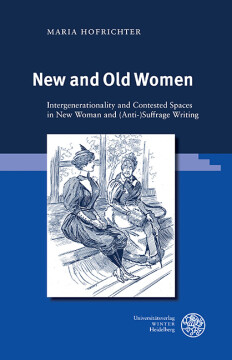
BUCH
New and Old Women
Intergenerationality and Contested Spaces in New Woman and (Anti-)Suffrage Writing
Regensburg Studies in Gender and Culture, Bd. 12
2025
Zusätzliche Informationen
Bibliografische Daten
Abstract
The generational divide between ‘new’ and ‘old’ women was a recurring theme in late Victorian and Edwardian literature and culture. This divide not only reinforced a rhetoric of difference but also encouraged discussions about productive exchange and collaboration between women of different age groups. Within the context of a rapidly modernising British society, these intergenerational dynamics were intricately linked to broader debates surrounding middle-class women’s evolving roles in society and their responsibilities towards their families. Through a comprehensive analysis of periodical and literary writings from the period, this study examines how cultural perceptions of gender, age(ing), and space shaped middle-class women’s aspirations to lead self-determined lives. It also highlights motherhood and the mother-daughter relationship as central tropes of female experience, analysing them against the backdrop of spatial conceptualisations and a renegotiation of female space.
Inhaltsverzeichnis
| Zwischenüberschrift | Seite | Aktion | Preis |
|---|---|---|---|
| Cover | Cover | ||
| Title | 3 | ||
| Imprint | 4 | ||
| Contents | 7 | ||
| Acknowledgements | 9 | ||
| Introduction | 11 | ||
| 1 Social, Medical, and Economic Discourses of Female Age(ing) | 23 | ||
| 1.1 Defining the Onset of Old Age | 24 | ||
| 1.2 Medical Conceptions of Female Ageing | 27 | ||
| 1.3 The Socio-Cultural Roles Available to Older Women | 34 | ||
| 2 Providing Room to Grow: Intergenerational Conflict and Collaboration in the Periodical Press | 47 | ||
| 2.1 Female Desexualisation at Midlife | 54 | ||
| 2.2 A New Mode of Spinsterhood | 61 | ||
| 2.3 Revolting Daughters and Conservative Mothers | 71 | ||
| 2.4 New Versus Old Women | 77 | ||
| 2.5 Continuity and Collaboration | 82 | ||
| 3 Possessing a Room of One’s Own: Self-Sacrifice and the Reclamation of Space in New Woman Fiction | 91 | ||
| 3.1 Visibility in the Public Domain | 94 | ||
| 3.2 The Appropriation of Private Space | 102 | ||
| 3.3 Confined Spaces and Dysfunctional Mother-Daughter Relationships | 107 | ||
| 3.3.1 “Virgin Soil” and the Motif of Entrapment | 108 | ||
| 3.3.2 ‘Choos[ing] Rooms for Mother and Me’: ‚Nobody’s Fault’ and the Dutiful Daughter | 119 | ||
| 3.3.3 Spatio-Temporal Confinement in ‚The Daughters of Danaus‘ | 129 | ||
| 3.3.4 ‚George Mandeville’s Husband‘ and the Subversion of Gendered Space | 145 | ||
| 3.4 Intergenerational ‘Dialogue Spaces’: Regeneration and Self-Determination | 157 | ||
| 3.4.1 From Pitiable Old Maid to ‘Tenderest Mother’: Surrogate Motherhood in ‚Joanna Traill, Spinster’ | 158 | ||
| 3.4.2 Female Self-Realisation and the ‘Secret Chamber’ in ‚The Beth Book’ | 169 | ||
| 4 Claiming the Public Sphere: The Fight for the Vote as a Fight across Generations in (Anti-)Suffrage Fiction | 187 | ||
| 4.1 Age, Leadership, and Political Power | 192 | ||
| 4.2 Staging a Public Performance | 202 | ||
| 4.3 ‘Motherhood of the Nation’: Maternal Reformism and Political Activism | 207 | ||
| 4.3.1 Maternal Responsibility and Political Commitment in ‚The Home-Breakers‘ | 209 | ||
| 4.3.2 ‘Led by the perpetual influence of the older mind’: Inadequate Mother Figures in ‚Delia Blanchflower’ | 216 | ||
| 4.4 Maternal Guidance and the Appropriation of Politicised Spaces | 227 | ||
| 4.4.1 ‚The Judge‘ and the Adulation of Heroic Mothers | 229 | ||
| 4.4.2 The ‘Little Old Lady’ as Political Agent in Ann Veronica and ‚The Call’ | 237 | ||
| 4.4.3 Imprisonment and the Maternal Role in ‚No Surrender‘ | 254 | ||
| Conclusion | 267 | ||
| Bibliography | 273 | ||
| Backcover | Backcover |


 Publishing Platform by CloudPublish
Publishing Platform by CloudPublish